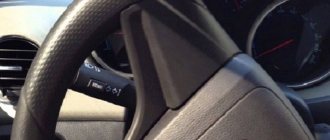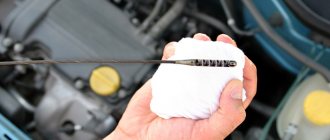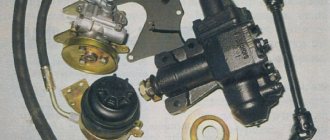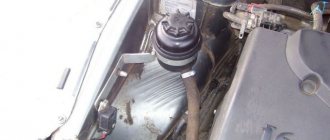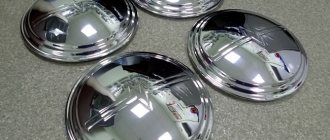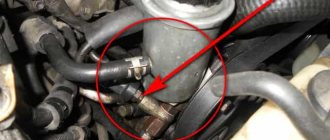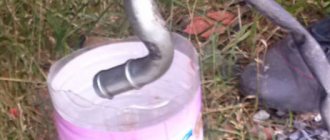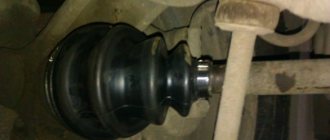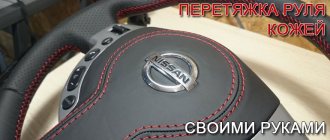The concept of play in the steering mechanism
In relation to the steering of a car, play is the amplitude of rotation of the steering wheel at which the car continues to move in the same direction.
A special rod, one of the steering elements, does not fit tightly to other parts, forming a gap. Due to this, the elements of the mechanism do not wear out during friction. The traffic rules set the maximum gap to no more than 10 degrees. Exceeding this value makes the car impossible to operate and requires immediate elimination.
Removing the gearbox
The design of the gearbox does not allow it to be repaired without removing it from the vehicle. In order to remove it, you must:
- Disconnect the tie rod ends from the gearbox. First, they are uncoiled, then the nuts are unscrewed with a 22 wrench and the tips are pressed out using a special puller.
- Unscrew the clamp securing the steering shaft to the gearbox.
- Remove the three bolts that secure the gearbox to the car body.
The gearbox design should not cause any particular difficulties when repairing it. You just have to take into account that the worn elements, called the worm pair, are both replaced at the same time. After this, adjustments must be made.
Many domestic car enthusiasts, including owners of the VAZ "Seven", are familiar with such a steering defect as steering wheel play. It is especially clearly felt when the car is moving at high speed in a straight line. The generally accepted way to identify the symptoms of this malfunction is to sharply turn the steering wheel. If it (the turn) is accompanied by a knock, there is play in the VAZ 2107 steering wheel.
The article brought to your attention will discuss the sequence of actions performed in the process of checking the technical condition of the steering mechanism, as well as when carrying out adjustment measures.
Causes of backlash
After a long period of operation, the working surfaces of the roller, bearing, bushing, washer, bipod shaft and its T-shaped groove, and the head of the adjusting screw become unusable. Thus, the gaps in the steering device increase, while the car is moving, extraneous knocks and vibrations appear, the wheels become unstable and wobble. Initially, a gap appears at the point of contact between the roller and the worm; subsequently, simultaneously with the steering shaft, an axial displacement of the worm occurs.
When traveling at high speed, the car becomes uncontrollable, which can lead to serious consequences, including an accident.
The main reason for the occurrence of backlash is the disgusting condition of the roads. The car's suspension takes on the bulk of the load, which is directed to the wheels, but some of it still falls on the steering parts. The situation is aggravated by the use of low-quality rubber, which significantly reduces the service life of the steering rod and suspension.
Loosening the nut
The “innocent” cause of the malfunction is the loosening of the steering wheel nut. Adjustment is performed by tightening the screw in the end cover of the steering mechanism. First, the decorative element of the fastening casing is removed, then the nut is tightened with a socket wrench of the required diameter.
If an airbag assembly is installed in the car trim (this applies to modern cars), it must first be dismantled to provide access to the nut. Work is carried out with the battery terminals disconnected in order to comply with safety precautions.
Important! If you do not tighten the fastening nut in a timely manner, this will lead to wear of the splines in the place where the steering wheel is attached, resulting in the steering wheel turning and loss of vehicle control.
Wear of rod ends
A more dangerous cause of play in the steering is wear of the rod ends. Due to the fact that these elements operate in difficult conditions, being constantly exposed to dirt and water, they deteriorate faster. As a result, the axial and radial clearances in the ball joint of the tip increase, it falls apart and driving the car becomes impossible. To avoid the consequences of such a malfunction, you should immediately contact service to replace parts.
Also, there are several reasons for the formation of free play, hidden in the design of the steering system.
- collapsed wheel bearing;
- loosening or improper tightening of the steering wheel nut and adjusting rods;
- wear of the ball joint;
- depreciation or breakage of hinges, splines, driveshaft joints;
- excessive gap between the toothed bar and the gear, or their wear;
- unsuitable hydraulic oil.
Where the backlash may appear
Video: How to eliminate steering wheel (steering shaft) movement.
- Let's go through all these connections. The cardan transmission allows you to change the angle of the column, providing greater comfort, although this is not its main purpose. The cardan transmission provides additional safety in the event of a collision, since in the event of an impact it makes it possible to change the position of the column without injuring the driver. This driveline is one of the most reliable connections in the steering, but it can also develop play. backlash in the cardan transmission is very simple, just hold the lower shaft connected to the gear with your hand, and turn the steering wheel with your other hand. Beating, knocking, and the possibility of even the slightest rotation of the steering wheel will indicate severe wear or damage to the driveline.
- The second connection, and one of the most important, is the rack and pinion. It is this connection that converts rotation into rack movement. And for accurate transmission, it is necessary to maintain the engagement between the teeth of these elements. Therefore, the design of the mechanism includes a rack stop, which presses it in the gear. The rack also moves along bushings, eliminating its oscillatory movements. But over time, the bushings wear out, as do the rack and pinion teeth, so there is play in the connection. At first, you can eliminate the gaps by tightening the stop to select the backlash, but ultimately you will have to repair the mechanism using repair kits.
- The next connection is the steering rods to the rack. The rods are attached to the rack using bolts. But to prevent the rods from transmitting the oscillatory movements that they receive from the wheels to the mechanism, there are eyes at the ends of the rods on the rack side, with silent blocks installed in them. These rubber elements perform a damping function. But over time, from exposure to the environment, auto fluids, chemicals. reagents from the road, the rubber component of silent blocks ages and delaminates. If severe wear of these silent blocks is detected, usually manifested by a strong knock from the steering mechanism, these rubber elements are simply replaced.
- The last connection of the steering is the tie rods with the steering knuckle. To ensure the mobility of this connection, steering tips are located at the ends of the rods. This tip is a housing in which the ball pin is installed. Thanks to the hemispherical surface of the finger, they have the ability to change the angle relative to the body. Moreover, the finger is seated in the body quite tightly, but during operation it wears out, leading to the appearance of play, accompanied by a knocking sound from the shock absorber struts. When play appears in the tips, they are replaced.
Video: Diagnostics of steering rods.
How to diagnose a malfunction?
Steering play is especially pronounced when driving on a straight road at high speed. A sign of a breakdown is a knocking sound when the steering wheel is turned sharply. An increasing knocking sound while driving on uneven terrain indicates damage to the steering ends and rods. Knocking into the steering wheel indicates a faulty steering bar.
If the steering wheel “beats” when driving, this indicates a failure of the ball joint or steering ends. The cause may also be wear of the bushing, bearing, or crosspiece.
A noise of unknown origin when turning the steering wheel indicates the need to check the fluid level.
A change in the given direction of movement of the car with the steering wheel in a straight position, the feeling that the car is “pulling” to the side, indicates an unbalanced camber - wheel toe-in.
The steering wheel turns jerkily if the steering bar is jammed. If it turns with force, you need to check the operation of the amplifier.
To find out if there are problems with the steering, you should do a small check:
- Start the engine and leave it idling.
- At the same time, check the operation of the hydraulic booster.
- Align the front wheels parallel to the longitudinal axis of the car.
- Turning the steering wheel in one direction and the other, record the moment when the front wheels begin to move. Play (free play) will be the gap that the steering wheel goes through before the wheels move.
To more accurately determine the gap, use a special backlash meter.
What is meant by total steering wheel play?
Another term that requires consideration is “total backlash.” It refers to the total angle, which starts from the extreme position of the steering wheel on one side when turning begins, to the opposite position when the car starts moving in the other direction.
To understand the principles of operation of the total backlash, it is important to understand the design and operating features of the control system. Based on the technical component, the operating principle of the backlash is as follows.
There is a rod in the transmission of steering rods, which is fixed with a small gap of one or two millimeters.
This distance is necessary to protect the steering system linkages from wear due to excessive friction.
The presence of a gap is a technological solution that allows you to keep the hook in the required position and not touch the surface of the teeth.
For the driver, this parameter represents free movement of the steering wheel, which allows for more precise control of the car and to feel at what moment the direction of movement of the vehicle changes.
Essentially, this is the total distance the steering wheel travels before the car moves to the left or right.
Many people mistakenly consider this phenomenon negative and try to get rid of it. You shouldn’t do this, because play in the steering is the norm for every car. Another thing is that it must have a strictly defined value.
An interesting pattern can be traced here - the larger the car’s dimensions, the higher the backlash indicator.
In the process of measuring the total backlash, a number of conditions must be met:
- The front wheels are located in a neutral position and stand on a hard (asphalt or concrete) surface.
- The steering wheel tires are dry and clean.
- The car engine is started. This is relevant if the operation of the power steering is tested.
- The tension of the power steering pump drive belt, as well as the level of the working fluid, must meet the requirements approved by the manufacturer.
The total play is checked by measuring the angle of rotation of the control wheel between the fixed positions for changing movement to the left and right.
To obtain accurate parameters, measurements are made two or more times.
Eliminating play in the steering
To adjust the steering, you will need the usual set of simple tools to adjust the mounts. All troubleshooting work is carried out in a garage with an inspection pit, overpass, or with a lift.
If the playmeter or manual diagnostics show unsatisfactory results, proceed to the following actions (the help of a partner will be required):
- Determine the source of the knock and check the operation of the suspensions.
- Try to tighten the steering bar.
- Holding the steering wheel, turn it from side to side within the limits of free play, while simultaneously observing the operation of the driveshaft near the rack and ball joints. And also monitor the tightness of the mating rods, which must fit exactly into one another.
- If the steering rack is not damaged, turn the adjusting screw to eliminate the play in the rack.
- Free play in the cardan shaft most often occurs due to lack of lubrication. It can be eliminated only by replacing the part.
- Backlash at the junction of the rods is eliminated by spot welding, which holds the parts together during operation.
- Repair or replace ball ends if necessary.
- Pay special attention to the serviceability of the tips and the integrity of the rubber boots.
- Check whether the steering wheel play has been eliminated.
If all actions do not lead to the desired result, all that remains is to completely disassemble the steering mechanism to determine which parts are faulty and replace them.
The safety of the driver and passengers directly depends on the proper operation of the steering mechanism. Correcting breakdowns and adjusting mechanisms is best left to professionals.
VEHICLE LAYOUT
There are three types of car layout:
- Front-engine - a car layout in which the engine is located in front of the passenger compartment. It is the most common and has two options: rear-wheel drive (classic) and front-wheel drive. The last type of layout - front-engine, front-wheel drive - is now widely used due to a number of advantages over rear-wheel drive: - better stability and controllability when driving at high speed, especially on wet and slippery roads. — ensuring the necessary weight load on the drive wheels. - lower noise level, which is facilitated by the absence of a driveshaft. At the same time, front-wheel drive cars also have a number of disadvantages: - at full load, acceleration on hills and on wet roads is reduced; — at the moment of braking, the weight distribution between the axles is too uneven (the wheels of the front axle account for 70%-75% of the car’s weight) and, accordingly, the braking forces (see Braking properties); — the tires of the front driving steered wheels are more loaded and therefore more susceptible to wear; - drive to the front wheels requires the use of complex narrow joints - constant velocity joints (CV joints) - combining the power unit (engine and gearbox) with the main gear complicates access to individual elements.
- The mid-engine layout—the engine is located between the front and rear axles—is quite rare for passenger cars. It allows you to get the most spacious interior with given dimensions and good distribution along the axles.
- Rear-engine - the engine is located behind the passenger compartment. This arrangement was common on small cars. When transmitting torque to the rear wheels, it made it possible to obtain an inexpensive power unit and distribute such load along the axles, in which about 60% of the weight fell on the rear wheels. This had a positive effect on the vehicle's cross-country ability, but negatively on its stability and controllability, especially at high speeds. Cars with this layout are currently practically not produced.
Cause of play in the steering rack
First of all, let’s analyze the principle by which the steering of modern cars functions. The steering wheel is connected through a universal joint to a device that is a hollow tube, usually made of duralumin. Inside this mechanism there is a gear rack, driven by a gear connected to a universal joint. The rack is connected through internal lugs to rods, which are connected through external hinges to the steering arms on the front suspension struts. As a result, when any movement of the rack occurs, the wheels turn. Therefore, even the slightest play in the vehicle’s steering system must be removed. After all, it is a serious problem that can lead to dangerous consequences, ranging from a delayed reaction to movement and ending with a complete loss of control of the car.
Play in the steering rack may appear for the following reasons:
- The steering wheel nuts are not tightened well;
- splined connections are worn out;
- the cardan joints of the intermediate shaft are worn out;
- the steering mechanism to the body has become loose;
- the gap between the gear and the rack has increased;
- tips are worn out;
- the rubber-metal hinges that secure the rods to the mechanism have worn out, or their fastening bolts have become loose;
- The adjustment rods have loosened.
Let us consider in more detail the main causes of backlash.
- Loosening the nut.
The most easily removable cause of play is the weakening of the steering wheel fastening due to the unscrewing of the nut that secures it. To fix this problem, remove the decorative trim and use the correct size socket wrench to tighten the nut. In most cases, modern cars are equipped with airbags, the module of which is installed in the steering wheel trim. To provide access to the fastening nut, it must be dismantled. The work must be carried out scrupulously; the battery terminals must be disconnected.
When the steering wheel nut is loosened, loss of vehicle control may occur due to wear of the splines at the joint due to the steering wheel turning on the axle. In this case, urgent repairs are required to remove the backlash. It will consist of mandatory replacement of parts that were damaged. The consequence of wear of the cardan joints on the intermediate shaft is the occurrence of a “gear wheel effect”, which consists in periodically rubbing the steering wheel during rotation. Due to this malfunction, vehicle controllability deteriorates, especially when driving at high speeds. Replacing the intermediate shaft is the only way to fix this problem.
- Play also causes loosening of the steering mechanism to the body or sedimentation of rubber gaskets between the steering mechanism and the body . To remove it, you should tighten the fastening nuts or replace worn-out rubber parts. Increasing the clearance in the rack gears is an equally unpleasant situation. It occurs due to wear on the contact surfaces of the gear and rack. In addition, quite often in this mechanism the gaps between the guides and the rack increase. In this case, the wear process proceeds several times faster if the integrity of the protective anthers is damaged, so it is advisable to remove the defect.
- Wear of rod ends . Of particular danger is the play that occurs due to wear of the outer rod ends, which are the weak link of the vehicle's steering system. The reason for the increased vulnerability of these parts is their operation in difficult conditions: they are constantly exposed to the destructive effects of dirt, water, etc.
It is recommended to fix this problem as soon as possible. The danger of the defect is that the vehicle may lose control due to destruction of the tip, which occurs due to a significant increase in the radial and axial clearances of its ball joint. The consequences of such damage are difficult to overestimate, so in such a situation it is recommended to urgently remove the defect - replace the tips in a car service center.
We recommend
The inner ends of the rods are attached to the steering mechanism using rubber-metal joints pressed into their ends. When these hinges wear out, a specific metallic knock appears. To remove the defect, it is necessary to press new parts into the rods. It is recommended to entrust this work to specialists, since only the auto repair shop has the necessary pressing equipment. The bolts that secure the rods to the mechanism may also come loose. To remove the backlash in this situation, you only need to tighten them to the torque specified by the manufacturer.
Loosening the adjusting rods . The next factor leading to the appearance of play in the steering is loosening of the adjusting rods that regulate the toe-in of the vehicle wheels. The problem occurs due to insufficient tightening of the bolts after adjusting the toe angle. The defect can cause the adjusting rod to jump out of the ends, so it must be removed.
The swing arms of some modern car models are not welded to the suspension struts, but are connected using bolts. When bolted joints become loose, play appears. To check whether this is the cause of this defect, lift the front of the car, remove the wheels and check the tightness of the bolts. This way you will adjust the steering.
Independently identifying the causes of steering rack play will not cause much difficulty for any car owner; you just need to have an assistant to perform some operations. To do this, place the vehicle on a level surface. Then open the hood and place the wheels in a straight position. While the assistant sharply turns the steering wheel in both directions at a slight angle, feel all the components whose malfunction may cause play. It will not be difficult for your hands to find the defective unit, since you will immediately feel a specific shift while rocking the wheel.
Let's sum it up
If you notice that the free play of the steering wheel has become greater than it was, then you should not ignore this event. Immediately check the condition of the front suspension and steering mechanism, or contact your nearest car service center. You should not drive with such a breakdown, as it can lead to an accident, and the consequences can be fatal. The cost of diagnosing this control system is affordable for everyone, and the parts that most often require replacement are also inexpensive.
The steering, including the free play of the steering wheel, must be checked at each regular vehicle maintenance or when such a need arises. During inspection you should pay attention and check:
— The location of the steering wheel spokes, which, when the front wheels are in a straight position, should be located symmetrically relative to the vertical axis.
— Condition of protective covers and threaded connections. Rubber covers that are torn, cracked or have lost elasticity must be replaced, otherwise water, dust and dirt that get into the units will quickly damage them.
— The condition of the hoses and pipelines connecting the power steering pump, its reservoir and the steering mechanism.
— Tightening the bolts securing the steering gear housing to the frame, tightening the wedges or bolts securing the propeller shaft of the steering column, reliable tightening and locking of the ball joint pin nuts.
— Lack of clearance in the ball joints of the tie rod ends, clearances in the upper and lower hinges and splined joints of the propeller shaft of the steering column, presence of clearances in the steering mechanism.
— No jamming, knocking or interference preventing the steering wheel from turning. If knocking and jamming is detected, the steering rods should be disconnected from the steering arms and the test should be repeated. If the knocking and jamming has not stopped, it needs to be removed and repaired.
The malfunctions affecting the controllability and directional stability of the UAZ-3160, UAZ-3162 and UAZ Patriot discussed in are also quite applicable to the steering of the UAZ Hunter with power steering.
Free play of the steering wheel or total play in the steering of the UAZ Hunter.
Steering wheel free play or total steering play is the angle of rotation of the steering wheel from the position corresponding to the beginning of the front wheels turning in one direction, to the steering wheel position corresponding to the beginning of the front wheels turning in the opposite direction. With increased free play of the steering wheel, it becomes difficult to control the car, since it reacts with a delay to the driver’s actions.
In addition, increased free play of the steering wheel, which cannot be eliminated by adjusting the steering mechanism, indicates some kind of malfunction of the steering: loosening of the steering mechanism, steering rods, lever or wear of their parts.
The maximum value of the total steering play set by the factory for UAZ Hunter cars up to and including 2010 is no more than 10 degrees. After 2010, for unknown reasons, this same play, according to the factory operating instructions, was increased and should be no more than 20 degrees.
In practice, measuring the free play of the steering wheel in degrees is not very convenient, so you should convert them into millimeters using the following formula L = (G/360) x 3.14 x D
.
Where L
is the free play of the steering wheel in millimeters,
G
is the maximum allowable amount of play,
3.14
is the number Pi,
D
is the outer diameter of the steering wheel, mm.
Signs of play in the steering rack
The occurrence of backlash is not determined by eye, which causes difficulties when trying to eliminate the malfunction. However, only the owner of the car can notice the first signs of its appearance. In this case, you may observe the following symptoms indicating a possible problem:
How to remove play in the steering rack? It is necessary to identify the problem in time. When conducting diagnostics, it is necessary to carefully examine the entire mechanism, identifying the weakest nodes. There are a large number of factors for the appearance of backlash, but they can all be attributed to a single reason - faulty interaction of control drive parts.
- Excessively stretched strip.
- Wear of the worm hook and gear bar.
- Damage to chassis parts - wheel bearings, steering rods, ends.
- Wear of gear teeth or rack.
- Failure to change hydraulic fluid in a timely manner.
a backlash meter can be used - a special device with which it is possible to detect a gap in the steering rack even before the first signs of a malfunction appear. When the indicators shown by the device are higher than normal, the problem must be removed. You can find clearance standards for vehicles in the traffic regulations.
Often the defect cannot be detected in time, which leads to the need to completely replace the steering mechanism. If the backlash indicator is too low, driving the car becomes less comfortable. If there is a strong gap, in order to control the car you have to “catch” it, that is, constantly turn the steering wheel. The most serious danger is the risk of losing control of the machine, so eliminating the malfunction is a task of increased importance.
If the backlash meter shows slight deviations from the norm, then you can deal with them yourself. However, the design of some models requires repair work to be carried out by professionals in auto repair shops.
Control of the amount of free play (play) of the steering wheel
I. Preparatory measures for checking the free play of the steering wheel include installing the vehicle on an overpass (inspection hole), bringing the tire pressure to the level recommended by the manufacturer, and selecting an assistant.
II. By rocking the steering wheel left and right, we determine the angle of rotation before the wheels begin to turn. It should not exceed (in each direction) 50. In addition, if the turning force is more than 20 kgf, or 196 N, this is a sign of a violation of the normal engagement of the elements of the steering gearbox (hereinafter referred to as RM).
Adjusting the engagement of the steering gear elements:
I. Set the wheels of the vehicle in a position corresponding to straight-line motion.
II. We clean the PM crankcase cover from dirt and lubricant leaks.
III. Using a screwdriver, remove the cap protecting the adjusting screw.
IV. Using a wrench set to “19”, loosen the nut that secures the adjusting screw. V. The assistant vigorously rocks the steering wheel left and right. VI. By rotating the adjusting screw, we adjust the amount of free play (reducing the force applied to the steering wheel) by increasing (decreasing) the engagement gap. Clockwise rotation ensures its (gap) reduction, counter-clockwise – increases it.
VII. Using a slotted screwdriver, fix the adjusting screw while tightening the nut. Reinstall the protective cap. VIII. We check the turning force at the extreme left (right) position of the front wheels, which allows us to find out the true degree of wear of the gearbox worm. If necessary, we adjust the engagement of the PM gearbox elements in one of the extreme wheel positions. IX. The implementation of the above measures ensures that the VAZ 2107 steering wheel plays within the limits specified by the manufacturer.
How to remove play in the steering rack with your own hands
How to tighten the slats yourself:
- To adjust the rack and remove play, tighten the adjusting screw located in the end cover of the steering mechanism.
- Use the overpass pit in the garage. If such ideal conditions are not available, jacks can be used to tighten the rack. Be sure to secure the machine after lifting on the jackstands.
- Align the front wheels straight (level) before lifting the car body using jacks.
- In accordance with GOST of the Russian Federation, the play of the steering mechanism should not be more than ten degrees. Measure it with a backlash meter: there are both modern electronic and primitive devices.
- Tighten the adjusting screw slowly. During the process, check the steering wheel travel, as well as the presence of a knock in the column or play.
- If you think you have corrected the defect, carry out a sea test. Did you feel the steering wheel feel heavy when driving? Then loosen the adjusting screw a little.
You have succeeded in eliminating the problem if the steering wheel returns to the center position without difficulty and no knocking or play is detected.
How to adjust play, also known as free play at the steering wheel on a VAZ 2101-VAZ 2107?
Note!
It is better to do the work with an assistant, as it is much easier and more convenient!
1) First, remove the protective cap that covers the column adjustment screw.
2) Then loosen the adjusting screw nut (Indicated by the red arrow) using a 17mm wrench. The nut must be loosened until the washer located under this nut can be lifted (Indicated by a blue arrow).
Next, when the nut is loosened, ask your assistant to sit behind the wheel of your car and sharply turn the steering wheel in different directions several times, while using a screwdriver, screw in the adjusting screw, which is indicated by the green arrow.
Note!
Do this until the play at the steering wheel is within normal limits. Also, do not over-tighten the adjusting screw, otherwise the steering wheel may become very difficult to turn!
Note!
After the completed operations, check the free play of the steering wheel; if the steering wheel is difficult to turn, then slightly loosen the adjusting screw by loosening the nut. If, after completing the work, the steering play remains the same or has moved but not significantly, and if turning the steering wheel is accompanied by squeaking and clicking, then have it repaired at a car repair shop or replace the steering mechanism with a new one!
The steering mechanism is a very delicate thing and therefore it is not recommended to repair it yourself, because if assembled incorrectly, the mechanism can jam on the road and therefore the car will stop responding to steering movements!
Question?
How do you adjust the free play of the steering wheel? (Write your answer in the comments)
Additional video:
You can watch more detailed adjustment of the free play of the steering wheel in the video clip located just below:
Every motorist understands perfectly well how important it is to maintain it in good condition, since otherwise getting into an accident is inevitable. Play in the steering is one of the most common faults that can occur not only in old cars, but also in new ones. If this breakdown occurs, you should immediately take measures to eliminate it. If you do not do this and continue to operate the machine, then each time it will be more and more difficult to calculate the trajectory of its displacement at the stage of maneuvers.
How to diagnose play in the steering rack and eliminate it: advice from car enthusiasts
1. “How to determine the backlash yourself”
I realized that my rods were loose while replacing the silent blocks in the front arms. I suggest this procedure:
- Remove the wheel.
- Unscrew the nut from the steering knuckle that secures the linkage to the steering knuckle. Knock out or remove the steering rod from the steering knuckle using a puller.
- Grab the rod with your hand and slowly move it back and forth along the axis. I was able to get a good feel for the backlash in this way. Weak efforts applied to the rod are a guarantee that it is the rod that is causing play and not the rack.
- Collect everything as it was.
Then check the second link in the same way.
We recommend
2. “The presence of play can be easily determined by the free movement, but you need to understand where it is”
- To check the outer tips, place your finger on the boot where the tip enters the hub, then jerk the wheel.
- To check the inner tip, feel the hinge on the extended boot and do the same as indicated in the first point.
- Play can also occur due to the ball joint, but when it is already dead, check with a mounting tool. Apply jerky pressure, being careful not to damage the boot or the joint between the ball and hub.
- When the steering rack gives play, both wheels will move; the slack may occur due to wear. To check, place the car in a pit and sharply pull the steering rod up and down. Tighten 5-10 0 if you hear a knock on the right. The steering wheel does not return to the rack when driving? Then you need to loosen it up. Please note that by adjusting, you remove the knock, that is, the gap between the tops of the teeth of the worm and the rack. However, it will not be possible to remove the free play, since the teeth are worn out and the angle of inclination does not match. Therefore, the knocking will return after some time.
The reason for the knock on the left is a broken support bushing, which means the rack needs to be repaired or replaced.
3. “Checking for backlash according to the inspection principle”
What is the easiest way to remove play in the steering rack? Carry out the check as during a technical inspection, when one person turns the steering wheel in different directions with the engine turned off, and the second person checks the rods and play in the rack for the presence of knocks. The play can even be seen, if the helmsmen are completely killed, and heard. To remove it, use the adjusting nut to tighten it (it seems to be set to 22) - counter it to 41. I did it this way: the assistant lightly turned the steering wheel in different directions, and I tightened it slowly, as soon as the knocking noise disappeared - countered it. Then he started the engine and drove a little, checking how the amp works and whether the steering wheel returns on its own after a turn. This is important, because if it is overtightened (which can be immediately heard from the operation of the amplifier), the hydrach will quickly break. All this is not difficult; if you wish, do not be afraid to make adjustments yourself to remove the defect.
4. “I made the adjustment alone at the dacha and drove from the dacha in a completely different car.”
I removed the fan and shroud, after which I was able to see the steering rack adjustment assembly. I made the key myself by welding a 27 nut (nut with a skirt) to the plate and bending the plate a little.
Didn't sharpen anything. I marked it with paint and unscrewed the locknut using a chisel, which I had previously extended by welding part of the round reinforcement. To remove the play, I installed the key, then turned it to the right until it stops, loosened it a little and locked it. Based on the mark, I turned the adjusting nut about 35-40 degrees.
5. “A few additions to replacing the steering rack”
After studying posts on the forum about replacing the steering rack bushing, I decided to take action. I removed the cover from the bushing side and saw that it was in poor condition and needed to be replaced. I would like to advise:
- When starting repairs to remove play, make sure that the cause is in the bushing itself, and not in insufficient tightening of the adjusting nut on it.
- The easiest option is to place a jack under the subframe. Almost completely unscrewing the nuts was not enough for the rack to come out.
- The marks on the nut will not help remove the defect, since in any case you will need to unscrew it until it stops.
- I was unable to get the shaft out until I loosened the adjusting nut on the rack.
- The shaft wear was significant where it rides on the bushing. In addition, I found rust on it, so I had to use sandpaper.
- To remove the malfunction, the easiest way to adjust the nut is with two people and on an assembled car: one turns the steering wheel, the other tightens it until the knocking in the rack disappears and a slight force appears on the steering wheel. Please note that the stabilizer must be unscrewed from the struts.
We recommend
Having replaced the rack assembly bushings, I drove the car. As a result, I realized: it was not possible to remove the knocking noises. Then I decided to tighten the adjusting nut on the rail. I would like to point out that I did something wrong earlier - I set the nut in the same position in which I twisted it. I tightened the adjusting nut and took the car for a spin. I was convinced that it was possible to remove almost all the knocks, except those coming from the stabilizer rubber bands.
I'm happy with the result - the rack doesn't knock at all. It is his own fault that the stabilizer rubber bands rattle when hitting speed bumps at an angle. It was necessary to change them at the same time when performing the previous operations in order to remove the fault.
Often the driver is faced with such a malfunction as steering play. This problem can lead to serious problems, so it is important to detect and fix the problem in time.
The steering is one of the most important for driving, and failure in the form of play is not one of the pleasant situations. Often the reason for the appearance can be various reasons, such as poor running gear, wear and tear of parts, and, most often, the condition of our roads. Therefore, we will consider how to identify play in the steering and how to carry out repairs.
Self-removal and installation of the amplifier
The steering wheel is hard to turn
You can do the procedure for dismantling and installing a new electric amplifier yourself, but for this you will need to prepare all the tools. To complete the job, you will need two screwdrivers - one with a flat head and the other with a Phillips head. You will also need a set of socket wrenches.
How to complete the DIY removal and installation task:
Before performing work, you will need to turn off the power to the on-board network of your Priora. To do this, turn off the ignition, then open the hood and disconnect the battery from power. After this, you will need to remove the steering wheel, but first remove the plastic trim located under the steering wheel and under the dashboard. The casing is attached to several bolts; they must be unscrewed and set aside. Removing the steering wheel is carried out taking into account the recommendations described in the service manual. When the trim is removed along with the steering wheel, you will see the connectors of the steering column switches to which the wires are connected. These plugs will need to be disconnected. The contact ring must also be dismantled. Using a 8-mm wrench, you will need to unscrew the bolt that secures the connector with the wires from the ignition switch. Set the bolt aside so you don't lose it. Once these steps are completed, press down on the plastic fasteners and disconnect the wiring connectors at the top and bottom of the steering column. Having done this, you will see a plastic curtain in the place where the electric amplifier is fixed directly to the speaker. You will need to remove it, which will also require you to remove the fasteners. Using a socket wrench, you will need to slightly loosen the nuts that secure the amplifier to the bottom of the speaker. Just loosen it, not twist it. When the nuts are loosened, you need to remove the electric amplifier from its seat; its removal is carried out with the intermediate shaft. But we recommend that you still disconnect the amplifier from the shaft; this will allow you to quickly clean the EUR and simplify the installation procedure. To disconnect the shaft, you will need to unscrew the screw that secures the universal joint to the shaft using a 13mm wrench. Having done this, you will also need to unscrew the two nuts located on the end parts, after which the entire steering column must be removed. Then you will need to remove the bolt and cardan from the splined pulley of the mechanism
In this case, pay attention to the labels - during further installation they must match in any case. The marks are located on the protective cover, pulley and starter mechanism cover
Now you can clean the electric booster and other system components or replace the failed EUR with a new one. The assembly procedure is carried out in reverse order.
The concept and causes of play in the steering mechanism
The steering design itself is not complicated. It contains a special rod that does not fit tightly to the car parts. It must have a small gap so that the parts do not wear out in case of friction. However, if the total play reaches fairly large levels, this can cause serious malfunctions, which can lead to accidents on the road. A backlash of 10° is considered an acceptable norm.
It is important to remember that a small play can develop into a large one, and therefore you should carefully consider this issue if there are clear signs of problems with the steering. These signs may include knocking, squeaking, vibration, or the need to turn the steering wheel hard to the left or right, even on a flat road. In this case, the steering wheel stops “obeying” the driver or performs actions somewhat late.
There are several reasons for the appearance of play and they all lie in the steering design itself. One of the first reasons may be that the tip or bearing has failed due to wear.
The second reason may be a recent car repair, namely the fact that sometimes the central hub nut is not sufficiently secured. This is where the backlash comes from. Also, free movement of the steering wheel may indicate that the hydraulic oil is becoming unusable and needs to be replaced.
In general, in order to discover the true cause of technical problems, the driver must check every detail of the entire steering system, since all parts and mechanisms are interconnected.
Malfunctions: legal aspect
Unstable operation of the control system, according to experts, is a serious factor destabilizing road traffic. Indeed, such a condition of the car seriously affects road safety. The driver is deprived of the ability to adequately control the trajectory of his vehicle, which can lead to loss of control and, as a consequence, disastrous consequences.
This determines the effect of the following legal norm prescribed in the traffic rules: the driver is strictly prohibited from driving with such defects. If they occur, you must stop immediately and try to eliminate them on the spot. If this is not possible, you should stop using the car.
The specified steering malfunctions are provided for by a special regulatory legal act - “Basic provisions for the approval of a vehicle for operation...”.
- The total play in the steering of the car exceeds the established values: for passenger cars - 10 degrees; for buses and trucks – 20 and 25 (respectively).
- There are movements of components and parts of the system that are not provided for by the design of the car.
- There is loose threaded connections.
- The power steering provided by the design is missing or in a faulty condition.
Even a cursory analysis of this list of faults will allow us to draw a conclusion about their extremely negative role in ensuring road safety. Serious administrative sanctions for driving a faulty vehicle also seem quite justified. The Code of Administrative Offenses of the Russian Federation provides for the removal of the driver from driving a car, the detention of the latter, the prohibition of its operation, associated with the removal of state registration marks from the car, as well as an administrative fine in the amount of 500 rubles.
How to determine the appearance of play in the steering
In order to check the car for problems with the steering, namely the presence of play, the following operations must be performed. First of all, it is necessary to switch the engine to a special operating mode when the vehicle is stationary - idle. After this, you should start turning the steering wheel and monitor the response time of the wheels to these commands. It is this distance that shows the amount of play.
Today, for the convenience and accuracy of measuring backlash, there is a special device - a backlash meter. It helps to measure and control the total backlash.
Repair and assembly
Correct and timely maintenance of the steering gear is the key to long-lasting and reliable operation, but there are times when breakdowns do occur. In this case, repairs with complete or partial disassembly simply cannot be avoided.
When repairing, it is necessary to pay attention to some features and important points, the use of which will increase the reliability of the mechanism and improve its characteristics
Steering gear repair
To remove and disassemble the gearbox, it is necessary to hang the front of the car and remove the steering rods. From inside, unscrew the bolt securing the supply shaft from the gearbox shaft. Next, we disconnect the gearbox from the spar by unscrewing the three bolts with spanners. In the engine compartment, remove the hoses and parts that are located in the line of the steering rods.
When the gearbox is unscrewed and removed from the shaft in the cabin, we pull it out of the engine compartment by turning the bipod to the left
Particular attention should be paid to the condition of the gaskets, their location and degree of wear. An unreliable seal can lead to loss of lubrication or contamination of internal cavities
The next step is to unscrew the plug and remove the oil from the steering gear housing, after which you need to unscrew the bipod.
We place the gearbox on a stand made of two boards so as not to damage the shaft splines and unscrew the nut, then remove the bipod. Additionally, you can screw the nut onto the shaft until the ends are mutually aligned. Next, disconnect the steering gear cover by gradually unscrewing the locknut of the adjusting bolt and remove the cover, gradually moving it towards the worm.
In this case, you need to be especially careful with the gaskets if they are in good condition; at the slightest jam or pressing out, the gasket must be replaced. The next step is to remove the bipod shaft, press in the worm shaft and remove the seals. All cavities must be washed and wiped with a rag, checking for dents, chips and any other damage. It is also necessary to check the crankcase for the presence of metal shavings, which indicates wear of certain parts. It is imperative to check the gaps and play in the mating parts and check the wear of the working surfaces. After carrying out a defective inspection of the steering gear, we replace damaged parts if necessary.
We carry out assembly in the reverse order, making sure to lubricate the parts with oil, and all oil seals with grease (lithol). Install a new cover gasket with an adjusting screw. We mount the bipod, tightening the nut as much as possible
Then we install the steering gearbox in its normal place, special attention must be paid to the connection of the worm with the intermediate shaft, distortions and misalignments are not allowed here
It is also necessary to align the direction of the bipod and the steering wheel. The average position of the bipod can be determined by counting the number of shaft revolutions and dividing by two. Next, tighten the gearbox mounting nuts (it is advisable to install new ones), attach the steering rods to the bipod. Fill the gear housing with oil and use the adjusting bolt to select the play in the steering gear. In order to avoid damage to wheel tires and loss of controllability of the VAZ 2121 car, it is necessary to diagnose the camber (toe) on a stand.
By adhering to these simple recommendations, you can improve the handling of the VAZ, increase driving safety, and the durability of the steering gearbox and the mechanism as a whole. The use of a worm-type steering gearbox on the VAZ 2121 has been justified for many years, not to mention decades. Having the need for periodic adjustment and maintenance, the gearbox ensures trouble-free operation throughout its entire service life. The simplicity of the design makes it possible to confidently operate the car in any road conditions, without fear that the steering wheel will fail. The gearbox has high maintainability and is easy to maintain.
Eliminating play in the steering
First of all, the check should begin with the universal joint and its screws. Turn the adjusting screw to the required value. Afterwards, check again for the presence and amount of play. If the results are unsatisfactory, do the work again.
If this does not help, then the cause of the breakdown lies elsewhere. The next step is to drive the car into the inspection hole. The problem of play may lie in the steering rod joints. Most likely, these parts are worn out and there is a need to replace them or firmly fix them. You should also check the fastening of the steering rods and tighten them if necessary.
However, if this does not eliminate the cause, then most likely you will have to disassemble the entire steering system. It is better to do this at a car service center, as there is a risk of damaging the system.
Is it effective?
Statistics say that tightening the steering rack gearbox really helps eliminate play. However, in 20 percent of cases the problem is not solved. First of all, this is due to the high wear of the drive transmission pair itself.
This is a rack and pinion. Also, the causes of play may be wear of the steering rod joints or loose mounting of the steering bipod. Therefore, adjusting the staff does not always give an effective result. So, if such symptoms are present, experts recommend checking the condition of the front suspension components. There should be no play on the tie rods, ball joints or suspension arms. At the same time, it is recommended to check the shock absorber. Its rod should move properly. On a MacPherson type suspension, its replacement is complicated by the fact that the element is assembled with a spring. A special press is used to dismantle it.
Cost of repairs to eliminate play in the steering
The price of a playmeter device is quite high and ranges from $400 to $800. Individual steering parts are represented by the following prices: bearing - from $12, nut retainer - from $16, steering rack rod - from $50, tie rod joint - from $16. At a car service center, repairs will cost around $20 or more, depending on the required service.
Video about steering play:
Is there any play in the steering wheel? Let's figure out what to do
Backlash is free movement in any device of a mechanical structure. It is measured as an indicator of the movement of any controlled node. In the case of a steering system, auto play means the amplitude of rotation of the steering wheel before changing the direction of movement, but the presence of such a feature implies a high probability of serious malfunctions. A special rod in the steering system creates a certain gap due to an insufficiently tight fit to other elements of the mechanism in order to minimize wear of parts. The permissible maximum gap of such a gap should not exceed 10 degrees, and a large value means the need to stop operating the vehicle and eliminate the malfunction.
Causes of backlash
Gradually, during the operation of the car, the surfaces of the mechanism parts wear out, and the gaps become larger. As a result, when the car moves, vibrations and unnatural noises appear, the wheels lose their former stability and become loose. The gap initially forms at the point where the worm and roller engage, and then the steering shaft and worm simultaneously move along the axis. When you pick up speed, the car becomes poorly controlled and the risk of getting into an accident increases.
- The main reason for the formation of play can be considered the poor quality of roads, when the suspension is forced to take on a large load. Part of this load falls on the elements of the steering system. The situation can be significantly aggravated when low-quality rubber is used, since this helps to reduce the service life of the suspension and steering linkage.
- A loose nut is another possible cause of play. This can be eliminated by tightening the screw in the steering wheel cover. To do this, you must first remove the fastening casing, and after that all that remains is to tighten the nut using a wrench of the required diameter. In modern car models, airbags are mounted in the steering wheel trim, so you must first dismantle this unit to gain access to the nut. This work must be carried out with the battery terminals disconnected to ensure safety. It is important to understand that if the nuts are not tightened in a timely manner, the splines in the place where the steering wheel is fixed begin to actively wear out, which leads to the steering wheel turning and a complete loss of vehicle controllability.
- Wear of rod ends is a cause that carries great danger. These elements are constantly exposed to dirt, so they become faulty quite quickly. The result of such a destructive effect is the formation of gaps in the ball joint of the tips, and if they are completely malfunctioning, it is simply impossible to control the machine. Fixing such a breakdown requires contacting a service to completely replace the elements.
In addition, some reasons for the formation of backlash relate to the design features of the steering system. These reasons include:
- Malfunctions of the ball joint and wheel bearings;
- Loosening the steering wheel fixing nut and adjusting rods;
- Failure of hinges, splines;
- Gear malfunctions;
- Low quality hydraulic oil.
Diagnostics
Steering system play is especially noticeable when driving straight at high speed. A malfunction may be indicated by a knocking sound when turning sharply enough, and a gradually increasing knocking sound when driving on uneven terrain is a sign of a faulty condition of the steering ends and rods. Failure of the steering bar is confirmed by the recoil of the steering wheel. If the steering wheel “beats” while moving, we can talk about broken steering or ball ends, malfunctions of the crosspiece, bearing or bushing. Unusual noises when turning the steering wheel should be a reason to check that the fluid level is sufficient. When the steering wheel is positioned straight and the driving direction changes, you should check the camber - the toe-in of the wheels, the balance of which is disturbed. Jerky turning of the steering wheel may be due to jamming of the steering bar, and large efforts when turning it require checking the functionality of the amplifier. To identify problems with the steering, you should perform a number of simple steps:
- Start the engine and ensure it runs at idle speed;
- Check the performance of the hydraulic booster;
- Install the front wheels of the car parallel to the longitudinal axis of the car;
- When turning the steering wheel in different directions, determine the moment when the wheels begin to move. Backlash in this situation is the period of steering wheel travel before the wheels begin to move.
To detect the presence of play, there is also a device called a play meter. With its help, measuring free play is much easier.
Elimination
To adjust the steering system, you will need a simple set of tools to adjust the mounting elements. The work can be carried out in a regular garage with an overpass or inspection hole. If the test results are unsatisfactory, you must use the assistant to perform a number of actions:
- Identify the source of the extraneous knock and check the performance of the suspension;
- Try to tighten the steering bar;
- When turning the steering wheel in different directions within the available free play, check the performance of the propeller shaft near the rack and ball ends of the rod. In addition, it is necessary to look at the degree of tightness of the rods;
- If there is no damage to the steering bar, it is necessary to eliminate the play in the rack by turning the adjusting screw.
The most common cause of play in the driveshaft is insufficient lubrication, and it can only be eliminated by replacing the part. Backlash in the area where the rods meet is eliminated by spot welding. If necessary, the ball ends should be repaired or completely replaced. After doing all this work, all that remains is to check whether there is any play in the steering wheel.
It is important to understand that the safety of the driver himself and the passengers in his car directly depends on the serviceability of the vehicle control system. If faults are identified in this system, it is recommended to entrust the work of eliminating them to professional specialists who have the necessary experience and knowledge.
The principle of operation of the mechanism
Before starting any repair work on the car, it is necessary to find out the operating principle of a particular mechanism. The steering rack is needed to transfer the physical forces applied by the driver when turning the steering wheel to a helical gear located on a bearing. Pressure springs guarantee high-quality contact between the gear and rack.
Adjusting the steering rack is an inherently simple task, and any driver can handle it. On average, this procedure takes from 1 to 2 hours, taking into account the preparatory activities. In what cases is such a lift required?
In what cases is it necessary to adjust the steering rack?
In the vast majority of cases, tightening the steering rack is required if there is knocking and play in this mechanism. However, you need to be aware that such repairs do not always help. These malfunctions may indicate banal wear of the gear or rack or its individual parts.
Tapping and pronounced play in the steering rack often occur for the following reasons:
- the transmitting pair (its engagement zone) requires adjustment and adjustment;
- there is a loosening of the fixation of the lever bracket, steering system housing, bipod;
- natural wear and tear of parts, ball joints.
A properly adjusted steering mechanism will eliminate any knocking and improve the comfort of driving an aged car. Therefore, if you notice that the car’s steering wheel turns tightly, you should not limit yourself to tightening the corresponding device; it is strongly recommended to add lubricant to the crankcase.
